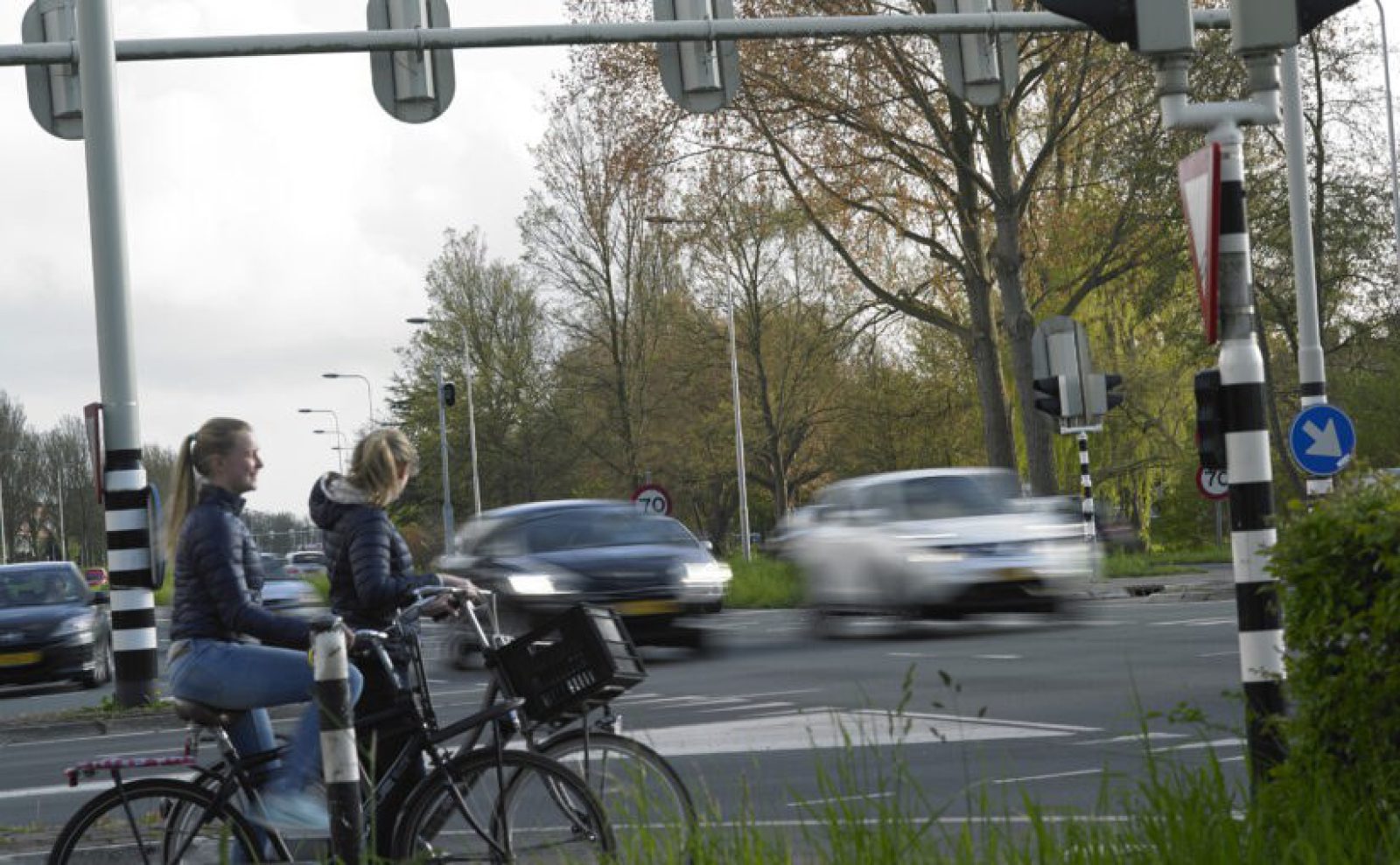
Speed reduction methods to promote road safety and to save lives
Speed reduction methods to promote road safety and to save lives
Introduction
The traditional and important road safety benefits of lower vehicle speeds include saving lives and reducing the impact and likelihood of crashes. However, speed reduction has important additional benefits that increase the quality of life for neighbourhoods and bigger urban areas, but also for society at large. These benefits include a reduction in traffic noise, pollution, greenhouse gases, average fuel consumption and barrier effects. Moreover, lower speeds will also facilitate local community spirit, cycling and walking that have wider health benefits for society. Speed reduction thus pays off in numerous ways.Speed reduction measures fall into the following categories: direct – infrastructure, vehicle technology and enforcement and indirect – signage, education and publicity. For this blog we will focus on the direct speed reduction measures. However, the importance of well-structured traffic and driver education policies, various active and passive signage methods and effective and constant publicity, especially when well-synced with enforcement, should not be underestimated. They serve to maintain awareness by the driving public of the dangers of speeding and the advantages of speed compliance.Similar to e.g. the smoking rate and the collective incidence of lung cancer, a small decrease in average vehicle speed across a road network will lead to a considerable reduction in traffic fatalities and the severity of injuries. This is hard to convey to the individual speeding driver with the narrow interest when running late for a meeting. Governments come in when such clear benefits to society at large need to be secured or promoted, despite perceived restrictions, constraints and limits to freedom felt by the individual.
Author: Philip J. Wijers
Infrastructure adaptations for speed reduction
An important measure to reduce speeds is the implementation of traffic calming infrastructure as suggested by Vision Zero and Sustainable Safety road safety strategies. This means a strategic review of infrastructure design criteria and infrastructure changes, starting with high-risk locations. Such measures can be highly cost and road safety effective and are relatively inexpensive to implement. They include:
1. Speed humps and raised platforms

Speed hump forcing speed reduction
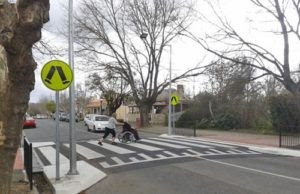
Raised pedestrian crossing (also with road narrowing) in Hahndorf, South Australia,
Source: Government of South Australia, Department for Infrastructure and Transport – https://www.dpti.sa.gov.au/
2. Gateway treatments
Gateway treatments indicate a new speed regime from a higher speed or access road e.g. when entering a built-up or residential area, school or increasingly popular Low Speed Zone (LSZ).
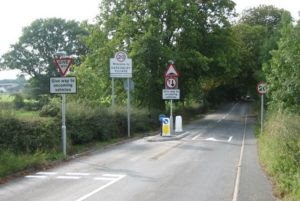
Gateway infrastructure treatments in the UK.
Source: SABRE – www.sabre-roads.org.uk
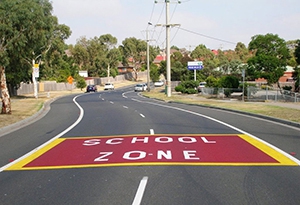
Gateway infrastructure treatments in Australia.
Source: SmarterLite Group – https://smarterlite.com/
3. Roundabouts
Roundabouts slow traffic at intersections and also make the potential impact angle of vehicles safer in case of crashes. Additionally, they are self-regulating which works well due to clarity about the right-of-way, lower speeds and a clear wider view. This video may be interesting: 5 minutes of traffic on a Dutch roundabout with bi-directional cycling lanes
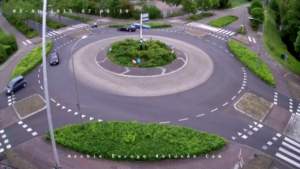
Roundabout Purmerend, The Netherlands.
Source: Archie Europe Rotonde Cam
4. Pavement narrowings and chicanes
Pavement narrowing and chicanes force lower traffic speeds due to required steering and yielding issues.
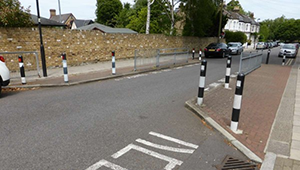
Road narrowing near a school in the UK.
Source: Right Driver – https://mocktheorytest.com/resources/what-are-traffic-calming-measures/
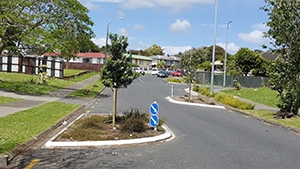
Chicane infrastructure in New Zealand
Source: Future Streets – www.futurestreets.org.nz
5. Optical markings
Treatments with optical markings give a feeling or illusion that the driver is going too fast. Speed should then be subsequently reduced.
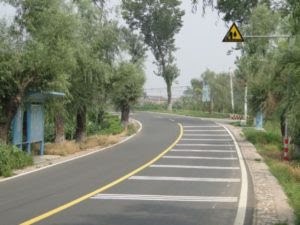
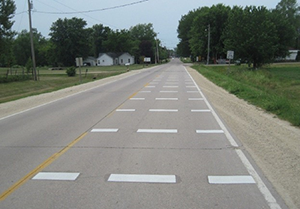
Optical methods to reduce speeding with higher marking density toward the curve or as gateway treatment.
Source: Federal Highway Administration – https://www.fhwa.dot.gov/publi...
6. Rumble strips
Rumble strips produce a vibration and rattling noise when crossed and draw attention and cause corrective action e.g. reducing speed. Rumble strips may be used as gateway treatment when entering a school zone, LSZ or urban area with a different speed regime. They can be used as a stand alone measure or in combination with speed humps, raised platforms or road narrowings.
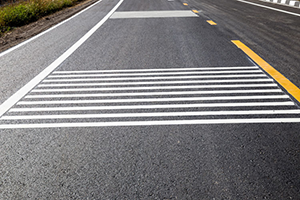
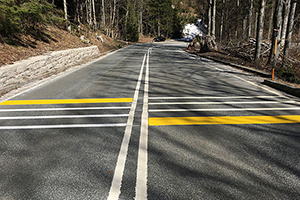
Rumble strips to reduce speeding.
Source: Swarco – https://www.swarco.com/not-found?ref=/products/road-markings/specialty-systems/rumbler
7. Alternative options
Several other options mostly related to the paragraphs above may also be relevant as infrastructure based speed reduction tools. They include corner radii adjustments, signal progression, diverters, speed kidneys, shared space and are listed in the references below.
Vehicle technology to reduce speeding
Vehicle technology is increasingly playing a key role in controlling speed. Technically it is possible to prevent any new vehicle from speeding by correcting the speed of the vehicle by relating it to the speed regime for its present GPS location, also in combination with local speed limit signage. And with the advent of automated driving, it is likely that speed regimes will be increasingly forced upon vehicles and its progressively more passive drivers.
Intelligent Speed Adaptation (ISA) involves any system that ensures that the speed of a vehicle cannot exceed the legally set or posted speed limit at that location. The information on potential speeding comes from sources such as GPS location, road maps, radio beacons, optical recognition (e.g. speed signs) and dead reckoning technology. In case of speeding and depending on the type of system, either the driver can be alerted or the speed can be reduced automatically. These two types of ISA systems differ in that passive systems only warn the driver about speeding, whereas active systems automatically intervene and correct the speed to the locally legal speed limit. Some passive ISA systems provide haptic feedback by increasing the force required to push the accelerator pedal in case of excess speed.
Most active ISA systems allow the driver to override the system when deemed necessary. This is likely to improve acceptance, but will also increase the risk of speeding. The ETSC (European Transport Safety Council) has been advocating the benefits of ISA for many years. Since 2009 Euro NCAP (New Car Assessment Programme) has been rewarding extra points to vehicles that include ISA. From 2022 all new vehicles on the EU market need to be equipped with ISA.
Enforcement to improve compliance with speed regimes
1. Enforcement in theory
Traffic enforcement is the final, but essential component of speed management. If, with all education and engineering related elements in place, speeding still occurs it needs to be disciplined with the objective to prevent similar behaviour in the future. Enforcement is a corrective method applied after a registered violation by punishing the violating driver or vehicle owner, mostly by means of fines and/or through a driver’s license point system.Depending on the legal framework, extreme speeding cases can lead to immediate driving license suspension or revocation and vehicle impoundment. All these penalties cause a specific deterrence since a specific driver or vehicle owner runs the risk of being directly disciplined and will thus refrain from violating traffic laws. But seeing traffic enforcement in action (e.g. by seeing enforcement activities on the road, PR campaigns, warnings on the radio, programmes on TV.) also has a preventive effect on the driving public in general. This effect is called general deterrence.
Traffic enforcement works best when the “subjective chance of apprehension”, i.e. the collective feeling of both general and subjective deterrence, is maximised. This is the case when the driving public has the perception that they can be fined for speeding and other violations on any road, at any location and at any time of the day, manually by police officers and automatic by various types of cameras, and will thus comply with the traffic laws and regulations. This subjective feeling is boosted by several factors: e.g. PR campaigns, visible enforcement actions by the police, a mix of overt and covert manual and automated enforcement that is unpredictable in place and time and that is difficult to avoid, but also by hearing a colleague complain about a speeding ticket at work. All this only works if the fines are felt as a severe enough punishment. Which is why some countries correct fines based on income levels.
2. Enforcement in practise
Speed enforcement can be versatile and wide-ranging: e.g. manual by police officers or automatic by cameras, overt or covert, moving or stationary, spot speed or average speed.
Manual speed enforcement takes place overtly or covertly by police officers or other authorised officials, mostly by confronting violating drivers by stopping them shortly after a violation is observed or registered from a driving vehicle or stationary position along the road. Manual speed enforcement is highly effective since the driver is immediately and verbally confronted with his or her violation by a police officer. Moreover, it is highly visible and thus contributes to increasing the subjective chance of apprehension which is a key aspect of traffic enforcement. However, when compared to automated speed enforcement by cameras, it tends to be quite inefficient and expensive from an operational point of view due to the high operational labour content and the relatively low number of violators caught per enforcement hour. But despite this, regular manual speed enforcement remains essential in the wide mix of enforcement methods.
Assuming an owner liability legal regime, as recommended by the European Transport Safety Council (ETSC), automated speed enforcement is operationally very efficient and pays off quickly with strong road safety benefits. A long range of academic studies have also confirmed this . Printed or electronic violations notifications are then sent directly to the vehicle owner’s address or electronic device, often a smartphone or PC. For even more efficiency, violation processing and fine payment monitoring can be executed centrally by national processing centres (e.g. France, Sweden and the Netherlands).With driver liability used in e.g. the Nordics, Germany, Switzerland and Japan violation processing is a bit more complicated and less efficient due to the facial matching requirement for the evidence. Moreover, making photos of the driver through the windshield of a vehicle can be challenging and prosecution rates tend to be much lower than in countries with owner liability.
Implementing automated enforcement requires a suitable legal regime, a reliable up-to-date vehicle register, strictly controlled high-quality license plate issuance and an internally well coordinated government due to the multiple stakeholders. It is important to first set up a proper legal, administrative and operational framework before even considering hardware such as cameras. The complexities of fulfilling all preconditions and securing the automated enforcement chain before the operational start is often underestimated by governments. Starting with a small number of cameras is also recommendable. Legal integrity and measurement accuracy should be guaranteed by independent type approval and regular verification. This presents the judiciary with an autonomous yardstick in case of legal challenges to violations.
3. Automated enforcement equipment
Automated enforcement systems are available with various detection methods such as radar, laser, piëzo and inductive loops, each with its advantages and disadvantages. Of all detection technologies, radar detection probably provides the best compromise, since cameras can be mounted high (> 3 meter), therefore with only limited occlusion (detection shadow e.g. due to high vehicles), no detector issues with road damage or resurfacing, less vandalism and risk to damage, limited soiling and weather related detection problems and lower maintenance costs.
Automated speed enforcement hardware became quite versatile and can be operated in a wide range of methods: mobile, in-vehicle, semi-fixed, fixed, handheld and average speed. The latter does not measure speed, but calculates the speed by clocking time over a measured distance between entry and exit cameras. Average speed enforcement is highly effective and controls the speed over a longer distance. And unlike spot speed measurement, the driver cannot escape a fine by braking or temporarily slowing down for the camera, a potential risk in itself. Moreover, average speed enforcement is seen as more fair by most drivers compared to spot speed cameras. Average speed enforcement offers great road safety potential for work zones, bridges and tunnels and longer point to point stretches with limited stopping or exiting options. Depending on the amount of traffic, these systems can also be networked for variable speed management in larger metropolitan areas with a ring road motorway infrastructure securing not only safety but also optimising traffic flow and limiting emissions.


Images: Average speed enforcement, speed calculated by the time measured over fixed distance.
The combined challenge of the increased use of speed camera warning technology and the huge cost of equipping the lengthy secondary road network with cameras was resolved with unmarked in-vehicle systems. These unmarked police vehicles can be operated in parked and driving modes and can measure the speed of both passing and approaching vehicles. The French Ministry of the Interior was the first to implement such systems, mostly on the extensive and high-risk secondary road network. Also due to an comprehensive and effective multi-media PR campaign and the covert nature of the enforcement operation, the subjective chance of apprehension was increased dramatically. This had an immediate and very positive road safety effects. In-vehicle systems are available for various suppliers. This YouTube video illustrates the concept: https://youtu.be/kfWjVj84X9E
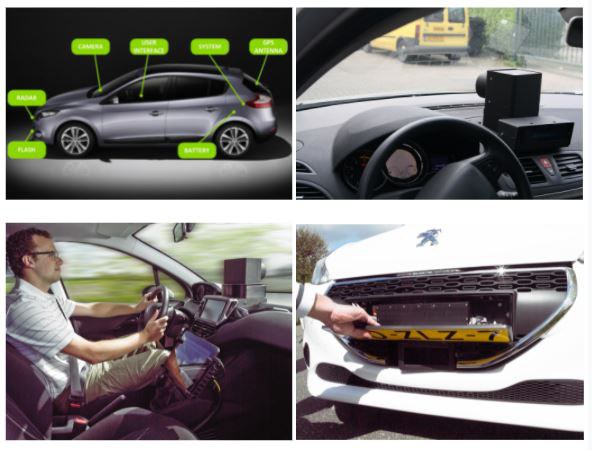
Images clockwise: In-vehicle system components, dashboard mounted camera, concealed radar and interior with camera and tablet display
Spot speed cameras remain important. But are, due to new alternative technologies, increasingly only to slow down traffic in specific locations e.g. school zones, LSZs and sharp curves at intersections or busy crossings. Depending on the circumstances, the value of fixed spot speed cameras on motorways and long straight roads has diminished somewhat, especially due to camera alerts from mobile devices and new more suitable enforcement technologies such as average speed enforcement and flexible in-vehicle systems. Semi-fixed systems (photo below) are battery operated (7 – 10 days) and can be moved around for temporary use e.g. for a local road safety measure or campaign. Tripod mounted systems (photo below) are used by the police in an automated enforcement arrangement. They set up the system for a couple of enforcement hours and then move for another session at a different location.

Images clockwise: Mobile, spot speed (2x) and battery operated semi-fixed camera enforcement
Conclusion
The three options presented are not meant as a contest for the best solution for speed management. These methods are complementary and, when feasible, should all be applied at the same time. On the other hand, speed humps are misplaced to reduce speeding on motorways and national secondary roads. Also, in narrow curvy streets in residential neighbourhoods the benefit of fixed speed cameras is limited. Speed humps, chicanes and other infrastructure measures are more relevant to encourage compliance with 30 km/h residential and other Low Speed Zone (LSZ) speed limits.
Most vehicle manufacturers already offer ISA systems, as a standard safety feature for new vehicles. In Europe they are also forced to do so when the new Euro-NCAP rules come into force in 2022.
Both manual and automated speed enforcement, as gatekeepers of proper driving behaviour, are a crucial cornerstone of road safety. The more recent automated enforcement technologies used in concert with comprehensive PR campaigns offer considerable opportunities to further increase the subjective chance of apprehension and thus increased speed limit compliance and safety on the road network. Besides the new automated speed enforcement methods and technologies, regular manual speed enforcement by police officers remains indispensable as an important speed management measure.
One of the key aspects to improve road safety is to reduce the average network speed of all vehicles on streets, roads and motorways. This reduces the aggregate level of energy in the road network and will pay off quickly in fewer and less serious crashes and thus casualties and injuries. All three methods mentioned can play a significant role in achieving this.
- Vision Zero – https://en.wikipedia.org/wiki/Vision_Zero
https://visionzeronetwork.org - Sustainable Safety – https://sustainablesafety.nl/
- Chicanes – https://www.sfbetterstreets.org/find-project-types/pedestrian-safety-and-traffic-calming/traffic-calming-overview/chicanes/ http://www.pedbikesafe.org/pedsafe/countermeasures_detail.cfm?CM_NUM=33
- Federal Highway Administration – https://www.fhwa.dot.gov/publications/research/safety/15030/005.cfm
- Rumble strips – http://toolkit.irap.org/default.asp?page=treatment&id=30 https://en.wikipedia.org/wiki/Rumble_strip
- https://globaldesigningcities.org/publication/global-street-design-guide/designing-streets-people/designing-for-motorists/traffic-calming-strategies/ https://www.fhwa.dot.gov/publications/research/safety/15030/009.cfm
- https://ec.europa.eu/transport/road_safety/specialist/knowledge/speed/new_technologies_new_opportunities/intelligent_speed_adaptation_isa_en
- https://etsc.eu/intelligent-speed-assistance-set-for-launch-on-all-new-eu-vehicle-types-from-2022/
- https://ec.europa.eu/transport/road_safety/specialist/knowledge/speed_enforcement/general_introduction_to_traffic_law_enforcement/general_deterrence_vs_specific_deterrence_en
- Cochane – https://www.cochrane.org/CD004607/INJ_do-speed-cameras-reduce-road-traffic-crashes-injuries-and-deaths
- SWOV – https://www.swov.nl/sites/default/files/publicaties/gearchiveerde-factsheet/uk/fs_speed_cameras_archived.pdf
